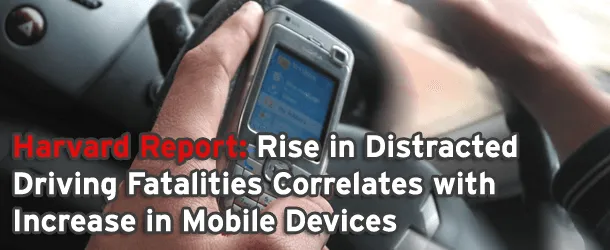By now, virtually everyone with a driver’s license has heard that distracted driving causes motor vehicle accidents. It’s a very important message, but it’s only half right. Distracted driving is indeed the culprit, but the calamities that result are not accidents. Far from being random, unpredictable events that qualify as accidents, the consequences of distracted driving are all too predictable. And since these car crashes are predictable, they are preventable.

If you understand the hazards of driving under the influence of cell phones and other mobile devices, you can arrive safely at your destination with enough time to make your calls and send your texts.
Triple Threat
There are three major types of distraction: visual distraction (taking your eyes off the road), manual distraction (taking your hands off the wheel), and cognitive distraction (taking your mind off the complex task of driving). All are important, and when they occur simultaneously, the risk multiplies exponentially (think texting).
Distracted driving is not a new problem. Things like eating or drinking, grooming, checking a map, fiddling with the radio, intense conversations with passengers, and mental preoccupation with personal or professional issues have been distracting drivers for decades. But the digital age has multiplied the hazards; cell phones, texting, and navigational devices have driven distraction to new and more dangerous levels.
Crushing Statistics
Each day, more than 15 Americans are killed and more than 1,200 are injured in car crashes that involve a distracted driver. In 2008 alone, the toll amounted to nearly 6,000 deaths and over 500,000 injuries–and the problem is getting worse every year. Over all, vehicular fatalities are declining, but the share of road deaths caused by distracted driving has risen to 16 percent.
Just who is driving while distracted? About three-quarters are white males; although no age group is immune, young men are disproportionally likely to be distracted drivers. Nearly two-thirds of distracted drivers are alone in the car at the time of the crash. About 60 percent do not involve another moving vehicle, and nearly 40 percent occur on urban roads.
The rise in death and injury due to distracted driving correlates well with the explosive increase in mobile devices. One estimate links every additional one million cell phone subscriptions to a 19 percent rise in distracted driving fatalities. At present, over 275 million Americans own cell phones, and 81 percent admit to talking while driving.
Although cell phones are responsible for many road fatalities, they can be life-saving in medical emergencies. And doctors are just starting to learn how to text for health. A 2011 study reported that a cell phone texting program (txt2stop) can help smokers break the tobacco habit. Let’s hope the texts don’t arrive while recipients are driving.
Texting to Death
Texting is a way of life in the digital age. In 2002, Americans sent one million text messages a month; by 2008, the volume had increased to 110 million a month, and the number continues to soar.
Texting is the most dangerous form of distracted driving; drivers who text are 23 times more likely to crash than non-distracted drivers. Since texting involves visual, manual, and cognitive distractions, it’s easy to see why it’s so dangerous.
According to a survey by the AAA Foundation for Traffic Safety, 14 percent of drivers admitted to texting while driving during the previous 30 days. At least 39 states and the District of Columbia have enacted laws restricting the use of mobile communication devices while driving, but enforcement is proving very difficult. In the last analysis, personal responsibility is the only way to contain the problem. To put the message in context: if u txt & drive u cn di.
Drunk Driving
Cell phones are a new threat to safe driving; alcohol is an old hazard. Taking some 11,000 lives a year, alcohol-impaired driving accounts for about one-third of the road fatalities in the U.S. – and men are responsible for over 80 percent of all episodes of drunk driving. Although the message is familiar, it merits repetition: Don’t drink and drive.
Look Officer, No Hands!
Talking on a cell phone is not as hazardous as texting while driving–but that doesn’t mean it’s safe. One study showed that drivers who talk on cell phones are four times more likely to crash than non-distracted drivers. That makes driving while talking on a cell phone as risky as driving while intoxicated.
Using a standard, hand-held cell phone involves visual distraction while dialing, manual distraction while holding the phone, and cognitive distraction throughout. In theory, hands-free calling should be safer, but actuarial data from auto insurance companies, experiments on driving simulators, and tests on tracks show that it’s not.
Talking with a passenger can be distracting, but talking on a phone is much worse. Passengers and drivers see the same road conditions and pause or modify their conversation accordingly. Passengers can even alert drivers to impending hazards–but people talking to drivers by phone will continue their distracting conversation without regard to driving conditions. With phone calls, the rhythm of talk and the rhythm of the road are out of sync; too often a crash is the result of cognitive overload.
At best, driving is a demanding and potentially hazardous activity; it’s no time for multitasking. As with texting, personal responsibility is the ultimate solution to the dangers of distracted driving. In our busy, networked, wired society, the temptation to talk on the phone while driving is strong. Remember that we got along without cell phones for decades. And while we’re thinking about the good old days, getting out of your car to do a little walking during that call or text will go a long way toward preserving your health.
– Harvard Men’s Health Watch
(C) 2012. PRESIDENT AND FELLOWS OF HARVARD COLLGE. ALL RIGHTS RESERVED DISTRIBUTED BY TRIBUNE MEDIA SERVICES, INC.
